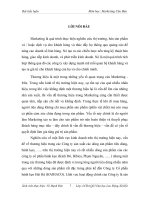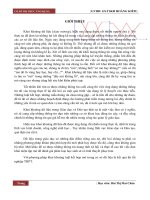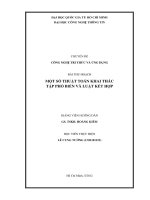Bài Tiểu Luận Môn Writing Lever 2 Topic “What Is The Format Of An Email Letter.pdf
Bạn đang xem bản rút gọn của tài liệu. Xem và tải ngay bản đầy đủ của tài liệu tại đây (1.98 MB, 11 trang )
<span class="text_page_counter">Trang 1</span><div class="page_container" data-page="1">
<b>TRƯỜNG ĐẠI HỌC DUY TÂN</b>
<b>------BÀI TIỂU LUẬNMÔN: WRITING LEVER 2</b><b>.</b>
<i><b>Topic:“What is the format of an Email letter?”</b></i>
<b>Teacher: Nguyễn Đào Bích Ty </b>
</div><span class="text_page_counter">Trang 3</span><div class="page_container" data-page="3">In today's digital age, email has become a ubiquitous mode of communication in both personal and professional settings. Whether you're sending an email to a
friend or colleague, it's important to understand the format and structure of an email letter. A well-crafted email can effectively convey your message and achieve your intended purpose, while a poorly written email can be confusing, unprofessional, and may not achieve the desired outcome. In this response, we'll
discuss the standard format of an email letter and provide some tips for crafting effective emails and some ways to respond to emails.
</div><span class="text_page_counter">Trang 4</span><div class="page_container" data-page="4"><b>TABLE OF CONTENT</b>
<b>TABLE OF CONTENT...3</b>
<b>WHAT IS THE FORMAT OF AN EMAIL LETTER ?...4</b>
<b>I.State the problem...</b>...4
<b>II.The fomat of an Email letter?...4</b>
<b>III.Reply to Email letter...7</b>
<b>CONCLUSION...9</b>
</div><span class="text_page_counter">Trang 5</span><div class="page_container" data-page="5"><b>WHAT IS THE FORMAT OF AN EMAIL LETTER?I.State the problem.</b>
<b>1.What is a letter?</b>
A letter is a written or printed message that is usually addressed to a specific person or organization and sent through the mail or other delivery services. Letters can be formal or informal, depending on the purpose and intended audience. Formal letters are typically used for business or professional communication, such as job applications, complaint letters, or official correspondence. Info rmal letters, on the other hand, are more personal and can include letters to friends or family, thank-you notes, or other casual correspondence. Letters often include a salutation or greeting, body text, and a closing or signature.
<b>2.What is an Email letter?</b>
An email letter, also known as an email message or simply an email, is a written or digital message sent through email software or webmail services. It is an electronic alternative to a traditional letter sent through postal mail. An email letter can include text, images, attachments, and links, and can be sent to one or multiple recipients simultaneously. The format of an email letter typically includes a subject line, a greeting or salutation, the body of the message, a closing statemen t or signature, and any attachments or links. Email letters are widely used for personal and professional communication, including business correspondence, job applications, invitations, and informal messages.
<b>3.The difference betweenemail letter and traditional letter.</b>
The difference between email and traditional mail refers to the distinctions between electronic mail and physical mail that is sent through postal services. The primary difference between email and traditional mail is that email is digital and is sent through the internet, while traditional mail is physical and is sent through the postal service. Other differences include the cost, spe ed, and convenience of sending and receiving messages. Email is typically faster, more convenient, and less ex pensive than traditional mail. Additionally, traditional mail requires physical delivery and may take several days to arrive at its destination, while email can be delivered instantly. However, traditional mail can be more formal and have a greater sense o f significance or importance, especially for legal or business correspondence and to see the convenience of email, we will now lookinto the structure of an email.
</div><span class="text_page_counter">Trang 6</span><div class="page_container" data-page="6"><b>II.The fomat of an Email letter?1. Identify the purpose of the email</b>
Before you compose an email, the first step is to identify the purpose of the message. Because email messages are easy to send, people can often misuse them or send them without a clear purpose. If you're gatheringinformation, you can ask yourself if emailing is the best option and if it's necessary. For example, you may find the information you're looking for in company training materials or through an internet search. After searching for the information and not finding what you require, you can ask yoursel f if there's someone you can ask or speak to in person.
If you determine that emailing is the best choice, identify the recipient of the message or inquiry. Be su re to address the message to the most appropriate person who's likely to have the information or provide you with insight into who else you may ask. If you're emailing a customer or client outside of the organization, ensure you have all necessaryinformation, such as the proper spelling of their name and email address. Next, define the purpose of the email to ensure that the message you write is concise and respectful of the recipient's time.
<b>2. Write the subject line of your email</b>
Once you identify the purpose of the message, you can write the subject line for your email. Creating an intriguing or impactful subject line can influence the recipient to open and read the email. Many individuals choose whether to open an email based on the subject line withoutknowing the content. It's best to keep the subject line concise and state the email's purpose in as few words aspossible while remaining informative.
An email recipient can only view a certain number of characters from a subject line. On a computer, the ideal length is less than 65 letters. If you type anything longer than 65 characters, the computer cuts off the remaining letters on the home screen. If you think the recipient is reading the email on a cell phone or tablet, use less than 30 characters in your subject line. Here are several subject lineexamples that encourage a response:
[Mutual contact] recommended I get in touch. Application for [job title] from [your name] Met at [event name]
How to [accomplish XYZ task] Please submit X form by [time or date] Meeting on [subject] at [time or date] Final approval needed by [time or date]
</div><span class="text_page_counter">Trang 7</span><div class="page_container" data-page="7"><b>3. Write the greeting</b>
Next, you want to write your greeting and address the email recipient. The tone of your greeting depends on who you're emailing. For example,if you're emailing a customer or client with whom you have a professional relationship, it may be advisable to addres s them formally, such as Dear Mr. Smith or Dear Ms. Pankar. If the connection is more casual, you can include a more relaxed greeting using the recipient's first name. Business emails you send towork colleagues are typically more informal than those you’s end to managers or people outside the organization.
Here are several examples of email greetings you can use: Good morning/afternoon/evening,
Hi [recipient's name], Hello [recipient's name], Dear [recipient's name],
<b>4. Create the body of the email</b>
Once you write the greeting, you can begin the body of the email. It's best practice to limit the subject of your message to one topic. Sending an email with more than one purpose can cause confusion and be inefficient. Limiting your topic allows for an email thread to remain concise and enables you to find the information easier in the future within your email inbox. If you ask several questions related to one topic, create a short, numbered list so the recipient can quickly identify what information you're reques ting.
Use the first several sentences of your message to identify your question or the purpose of the email. To create a rapport with the reader you can include a short sentence of interest, such as "I hope this email finds you well." You can also use these introductory lines to remind the recipient of a mutual connection or how you met. Follow your introduction with no more than three sentence s to detail the purpose of the message. Use clear, polite language to ensure the reader understands your request. Also, bring attention to any attachments you include with the email.
<b>5. Write the conclusion</b>
Once you complete the body of the message, you want to write your conclusion. Within the ending of your email, you want to include a call to action, a closing remark, and your email signature. The purpose of adding a call to action is for the recipient to identify how you want them to respond. For example, you can restate the question you asked or include a simple phrase such as "please respond to this email." When writing your closing remarks, remain professional and friendly. The formality of the conclusion depends on the professional relationship you have with the reader.
</div><span class="text_page_counter">Trang 8</span><div class="page_container" data-page="8">Some examples include: Best wishes,
Thank you for your time,. Kind regards ,…….
Following your closing remarks, you can include your email signature. An email signature is like a business card because it provides a professional presentation of your contact information to use during the first few communications you have with the recipient. After establishing a relationship, you may not want to include the entire signature and simply sign your first name. Many organizations have a pre-formatted email signature that employees use. If you don't have one, provide your full name, job title,company name, phone number. You can add social media platforms or website information if it applies to the conversation.
<b>6. Edit and proofread the e mail before sending.</b>
Reviewing the email at least once can ensure the content is concise and intentional. Next, add necessary recipients to the To line. These are the individuals you addressed in the greeting and the ones you want to respond. For others who may need the information in the email, you can include their email address in the CC line. If the email has multiple recipients and you would like to keep their email addresses private, remember to use the BCC address line.
Before sending the email, als o ensure that you attach any documents or files you reference in the message's body. Here areseveral considerrations when editing and proofreading your email:
Spelling, grammar, and punctuation are correct. Remove unnecessary words, phrases, or details. The recipient's email address and name are correct. You attached any referenced documents.
The subject line is concise while accurately communicating the purpose of the email.
The purpose of the email is clear. You included a call to action.
<b>III.Reply to Email letter.</b>
-You will be given specific explanation and description on what to include in your response.
</div><span class="text_page_counter">Trang 9</span><div class="page_container" data-page="9">- You will be given specific suggestions and requests on what to include in your response.
- In many cases, the e-mail requesting information will essentially ask for instructions. Therefore, you will need to respond using commands. The following are commands: go to bed! And bequiet!
Commands are easy to form in English. They are simply the infinitive form of the verb, withou t to. For example, the command form of the verb to go is go. The command form of the verb to beis be. Commands do not have a subject with them- they always refer to the person you’re talking to.
In addition to straight commands, native speakers often use sof t commands, or slightly morepolite ways to suggest that someone do something. Some common ways of suggesting thatsomeone go to the store include:
+Will you please go to the store? +Why don’t you go to the store?
</div><span class="text_page_counter">Trang 10</span><div class="page_container" data-page="10">+Could you go to the store?
+You should (probably) go to the store. +You could go to the store.
+You might try going to the store.
Although the question forms are very common in spoken English, they don’t quite as well in e-mail because they implicitly ask for a response from the other person. Therefore, for theremainder of this chapter we will use only the final three forms from above:
+You should (probably) go to the store. +You could go to the store.
+You might try going to the store.
</div><span class="text_page_counter">Trang 11</span><div class="page_container" data-page="11">In summary, the format of an email letter typically includes a subject line, a greeting or salutation, a body containing the main message, and a closing that includes a signature. It's important to keep the language and tone professional, use proper spelling and grammar, and keep the message concise and to the point. Additionally, it's important to consider the recipient's perspective and to ensure that any attachments or links included are relevant and appropriate. In addition to the format of an email letter, users should also know how to respond to emails effectively. It's important to start with a clear and concise subject line that accurately reflects the content of the email. When writing the email response, users should be polite, professional, and address any specific points or questions raised in the original email. It's also important to proofread the email before sending to avoid any spelling or grammatical errors. Finally, users should be prompt in their response and should avoid sending unnecessary or irrelevant messages. By following these guidelines, users can effectively communicate through email and build positive professional relationships.
</div>








